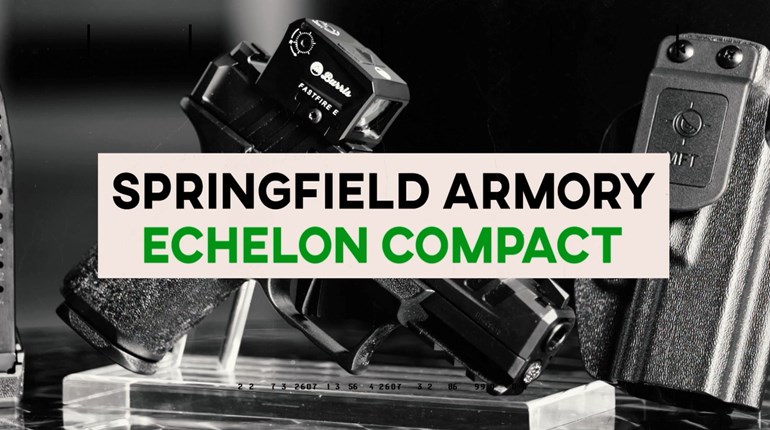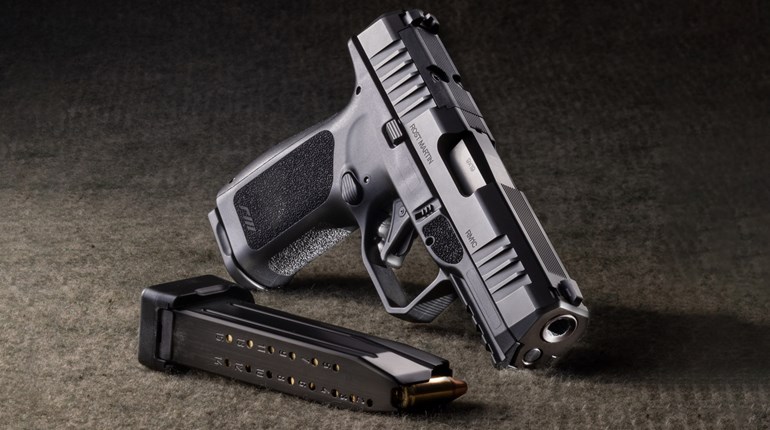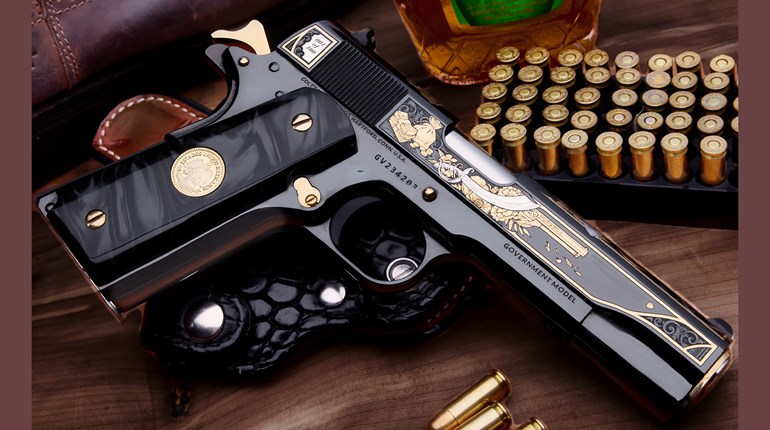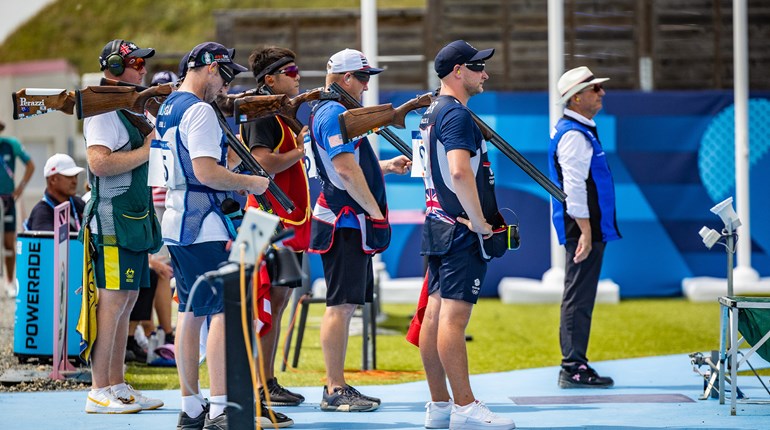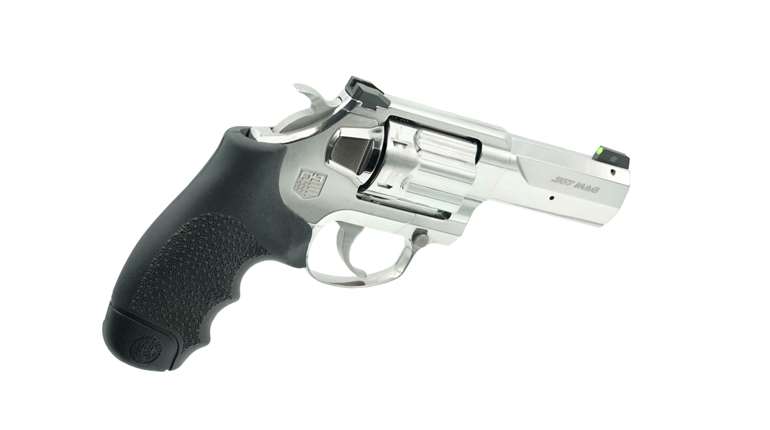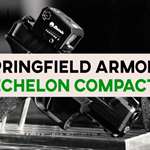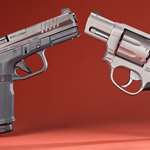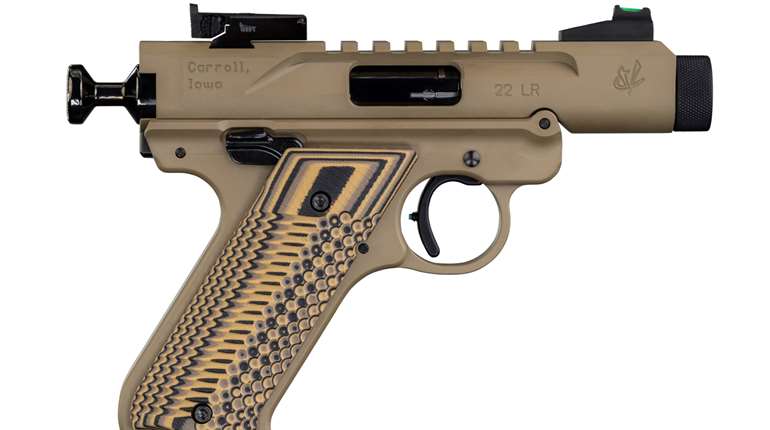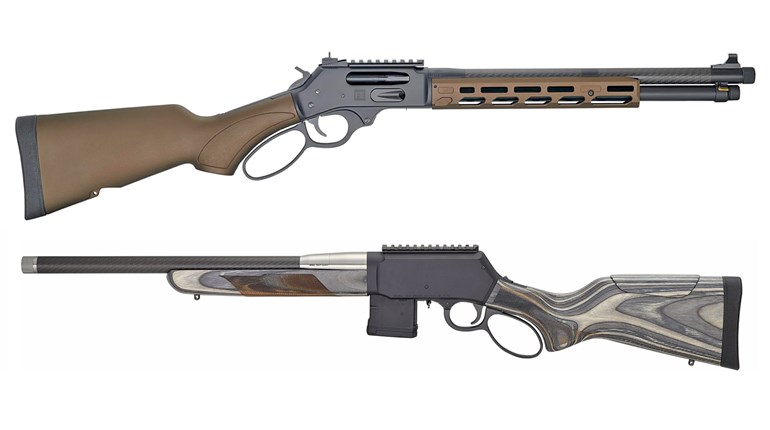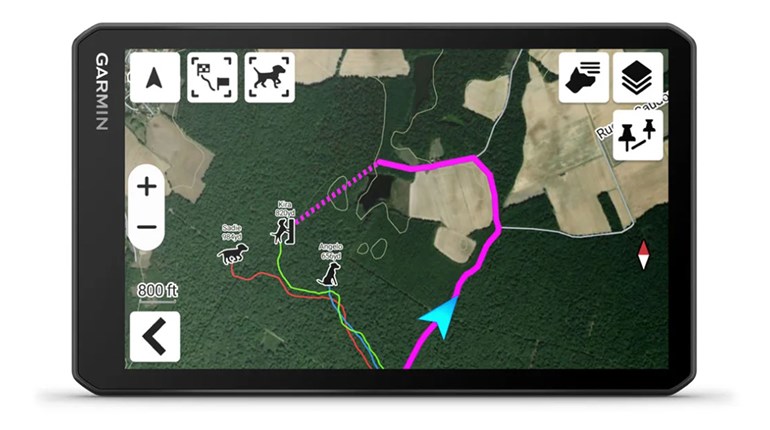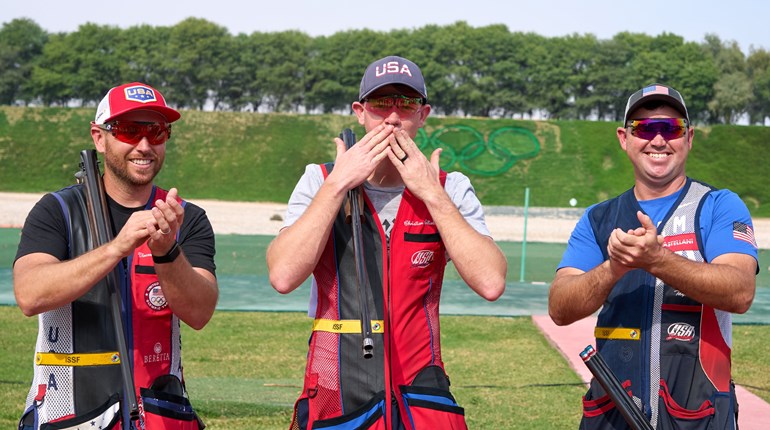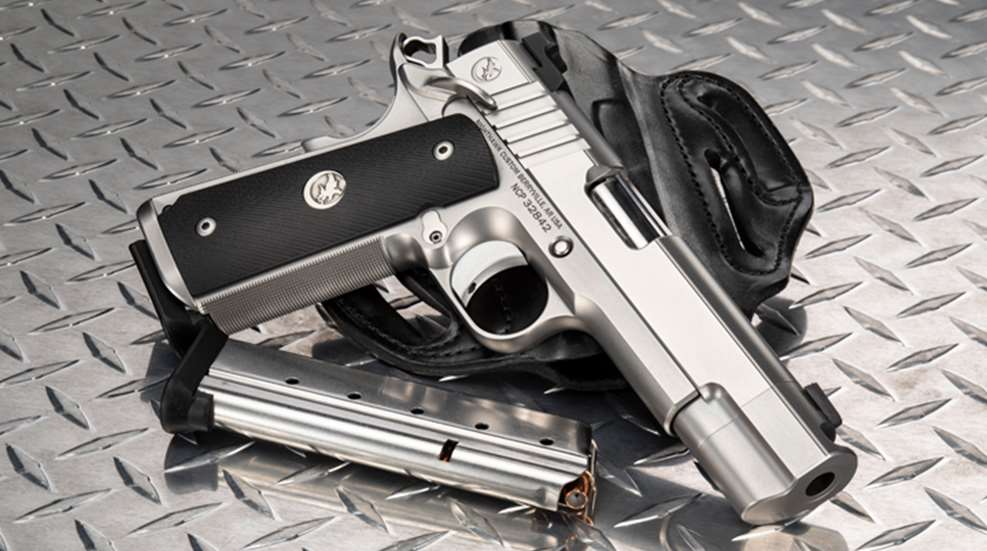
It’s been said that with age comes wisdom, but perhaps that’s only for the lucky ones. Birthdays come with age and for most, the culmination of becoming another year older is often celebrated with the receipt of gifts. And, once you reach a certain age (often 65), you can begin to collect social security as well as begin to take advantage of discount programs that offer monetary savings for things like meals, hotel stays, movie tickets and health care, just to name a few. But there’s another side to that coin.
For shooters—and especially concealed-carry licensees—birthdays bring an assortment of unsolicited ailments/deficits such as arthritis, less hand strength, a reduction in motor skills and a subsequent growing sensitivity to recoil. Afflictions like these are enough to convince some to stop shooting/carrying concealed. For others, however, the realization can cause shooters and concealed-carry licensees to begin searching for a worthy compromise—another handgun chambered in a softer-recoiling cartridge, but one still capable of delivering terminal performance—on par with—or similar to their original cartridge of choice.
A recent review of the Smith & Wesson Model 610 by friend and fellow gunscribe, Dick Williams, revealed that such challenges are more common than I originally perceived. He writes, “Big-bore revolvers and I have had a passionate love affair my whole life. However, their recoil can be demanding for both beginning shooters and more-mature shooters alike. Luckily, Smith & Wesson’s Model 610 revolver makes it a little easier for everyone to enjoy a larger-caliber revolver.”
In addition to taking solace in knowing I wasn’t alone, the notion suggested if he could find a solution where he wasn’t forced to abandon big-bore wheelguns, there had to be a similar solution where I could continue shooting my favored semi-auto pistol of choice: The 1911.
While it’s true fans of the 1911 platform need not look too far to find myriad offerings chambered in calibers other than .45 ACP, such a selection becomes a bit more challenging when viewed through the prism of one that is designed for optimal recoil control. One possible solution that came to mind is a pistol featuring a factory-ported compensator that is integral to the barrel. A cursory search of the Internet revealed a handful of manufacturers offering such an old-school yet innovative solution. (I'm not the only one looking for solutions dealing with the effects of recoil.) The pistol that appealed to me the most is Nighthawk Custom’s Fire Hawk.
Since its doors first opened in 2003, Nighthawk Custom has work diligently to become a source for superbly crafted and highly customized 1911s of uncompromising quality and exquisite attention to detail. Despite its long history of building 1911s for personal protection, the company is no stranger to pushing the envelope. One look at the Fire Hawk—especially its muzzle—is enough to suggest its cues came from elsewhere: Competitive shooting. That’s not to say however, that the company is getting into building raceguns. To understand the reasoning behind the Fire Hawk, a history lesson (along with a closer examination) is required.
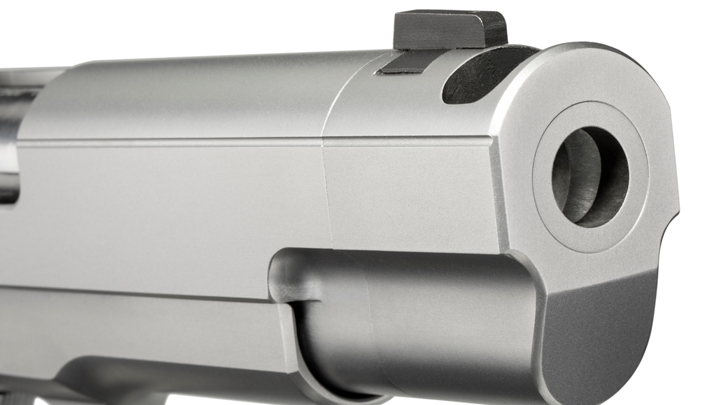
Back in late 1970s, after years of independent efforts around the country, the landscape of competitive shooting underwent an evolution to move from quick-draw “leather-slap” matches to a more practical style of shooting that built upon handgun skills and self-defense-oriented training, which resulted in organizations such as the International Practical Shooting Confederation (IPSC) and its national-governing body, the United States Practical Shooting Association (USPSA).
During this timeframe, custom gunsmiths and early IPSC competitive shooters engaged in various creative ways to lessen the effects of felt recoil and muzzle flip with such things as longer slides and adding more weight in front of the pistol with dual-purpose devices, such as compensators and/or muzzle brakes. Some folks got really creative by shortening slides and added compensators—bringing the guns back to full size. Enter the Fire Hawk: A Commander-length slide paired with a compensated barrel to duplicate the length of a Government Model atop a standard-size frame. However, while the Fire Hawk may share the dimensions of America’s Old Warhorse, that’s where the similarities end.
While only the second 1911 I’ve reviewed by this manufacturer, it’s my experience that Nighthawk-brand pistols are far from run-of-the-mill. One main distinction is the company’s construction is rock-solid—suggesting that only a single chunk of steel is used in the pistol’s composition. While impossible, however, their tolerances are tight enough to generate a superb fit, with no play, rattle, wobble, or excessive movement of its components.
Measuring the same length as a Government Model 1911, the Fire Hawk’s handling characteristics are far from typical. Taking the pistol in hand, its heft is immediately apparent, but not unpleasantly so. The pistol tips the scales at slightly more than 43 ounces, which is a mere 2.5 ounces heavier than a standard Government model of the same chambering. The additional mass is located forward of the frame and the slide. However, the Fire Hawk’s shortened slide actually weighs slightly 2 ounces less than an OEM slide. This means, unlike many semi-automatics where most of the weight resides in the portion of the pistol you hold, a portion of the Fire Hawk’s mass is located in the pistol’s business end, namely around the muzzle.
More than an aesthetic whim, the top of the Fire Hawk is adorned with a hole that, at first glance, appears to be integral to the slide. Upon closer inspection, the pistol’s 5-inch, National Match barrel is capped with a single-port compensator that has been expertly blended into the slide. Despite adding a noticeable muzzle-heavy heft to the pistol, both components virtually appear to be one. The addition of an attractive French border serves to aesthetically unite the compensator and slide. While not as seamless as some examples I have seen, it does add an element of class.
Locking the slide rearward, which cycled silky-smooth—as though gliding across ball bearings—reveals a bull contour to the barrel. In addition to serving another means of recoil-dampening mass, the tapered contour also eliminates the need for a barrel bushing. A call to the firm’s expert technicians revealed that slide reciprocation is powered by a 9-pound recoil spring that is captured on a guide rod and capped with a reverse plug. The barrel is match-grade and sports an integral feedramp for flawless feeding.
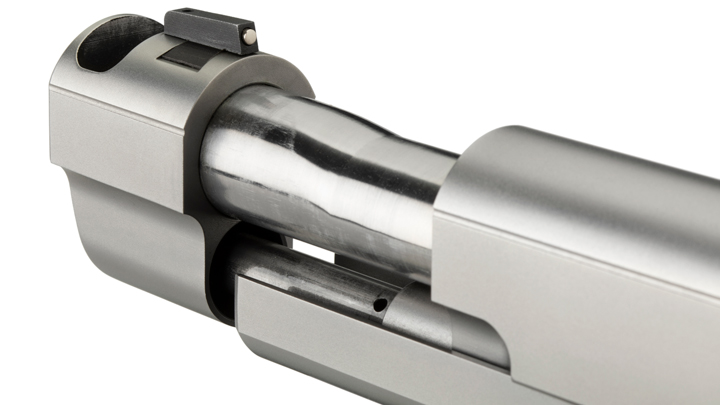
While the Fire Hawk may sport features with origins in competitive shooting, those same features make it ideally suited as a defensive guardian. How so? The compensator contributes in multiple ways.
First, when a shot is fired, propellant gases are vented upward through it, which applies a downward pressure to the muzzle. Second, consider the compensator’s shape: Being the same width (i.e. full contour) as the slide, all that extra steel equates to strategically placed mass directly below the barrel.
The combination of the porting and the added weight helps the shooter to not only shoot quicker, the mass aids in faster sight recovery and quicker follow-up shots. In a nutshell, the compensator promotes greater controllability of the pistol. In other words, if you’re looking for a pistol designed to hammer targets, this is it. But that’s not the only thing it has going for it.
Unlike conventional semi-auto pistols, the Fire Hawk’s front sight is mounted in a dovetail located directly behind the port on the compensator instead of on the slide. In addition to creating a longer sight radius for greater accuracy potential, anchoring the sight directly to the compensator works to minimize movement, while simultaneously enhancing overall sight clarity and reacquisition.
The front post is topped with an actual 24-karat gold bead, capable of quickly drawing the eye in a variety of lighting conditions. At the opposite end of the slide, is a fixed Heinie solid-black Slant Pro rear aperture. The notch area is recessed in a pocket, providing a crisp, protected sight picture that aids in rapid alignment under stress. This sight also sports dual setscrews to provide an uncompromising interface capable of shrugging off abuse.
The absence of dots or other reference points is quite refreshing and makes for a nice, welcome and clean addition, in that the lack of extraneous dots makes for a simple, intuitive and above all, ultra-fast sight picture. The gold bead seems to be coming back into EDC gun fashion as a practical alternative to tritium, as it is sufficiently visible in ambient light (be it urban or suburban environments) and, users avoid the hassle of having to replace radioactive lamps that will eventually lose their glow over the years. As an added bonus, the addition of a flat surface on the rear assembly aids in one-handed malfunction clearance.
In keeping with the Fire Hawk's concealed-carry design, its beavertail grip safety has a raised palm swell on the rear to aid in quick deactivation, while the tang portion promotes comfort while reducing the likelihood of snagging on clothing during the draw. An Ultra Hi-Cut frontstrap promotes a purchase-enhancing grip and furthers overall controllability by bringing the hand closer to the bore, which ultimately translates to less felt recoil.
Perfectly executed 25-LPI checkering on the frontstrap and the backstrap paired with black G10 grips with Nighthawk medallions offer a comfortable non-slip tactile surface without the skin-abrading bite. The dished-out area on the right panel aids in reaching the pistol's slightly extended, checkered magazine release. The bottom of the pistol features a one-piece mag well/mainspring housing.
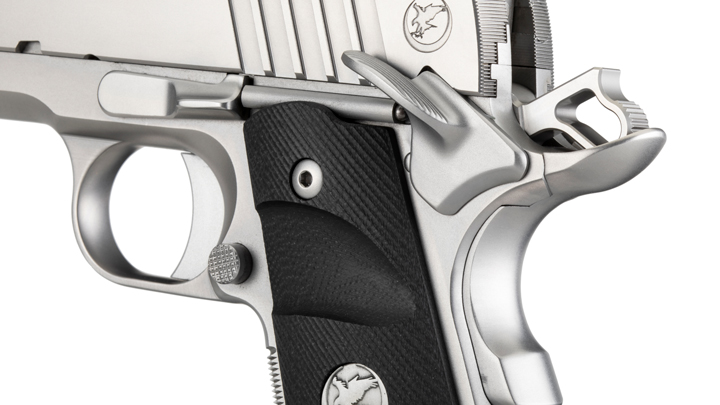
The Fire Hawk is fitted with a skeletonized hammer and medium-length solid trigger, which promotes easy access even with gloved hands and broke at crisply at slightly more than 4 pounds. To accommodate my southpaw affliction, a sublimely contoured ambidextrous thumb safety was fitted the pistol. (A single-sided variant is normally included.) Its narrow ledges foster easy deactivation while providing just enough real estate for my thumb to comfortably reside while shooting. In testing, the cavernous hole of the one-piece mag well facilitated effortless reloads—a huge plus given my fused wrist and limited fine-motor skills due to my cerebral palsy—and although it extends the grip by slightly less than a quarter inch, I find it a practical addition, especially to a carry pistol.
Prior to heading to the range, I fieldstripped the pistol to add a touch of lube as suggested by our Skills Check editor Ed Head. Despite the test sample’s tight tolerances (which contribute to and are needed for the pistol’s superb accuracy), a hole in the guide-rod allowed the recoil spring to be easily compressed with aid of the included takedown tool. I was surprised at just how easy it was to disassemble and put back together with minimal elbow grease required—quite often, 1911s with tight tolerances can be difficult to take apart and reassemble. It required little to no jostling, shifting or shaking of parts. The simple, but essential process ushered an epiphany: This superlative engineering, dear reader, is exactly what consumers pay for when purchasing a Nighthawk Custom pistol.
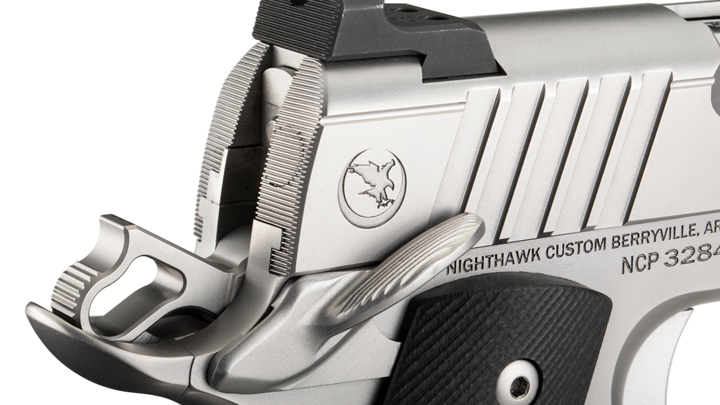
Prior to evaluating the Fire Hawk, the experimentation I did regarding recoil mitigation involved reviewing assorted aftermarket so-called 1911 “recoil-reducing systems,” which do work, but they consistently revealed lackluster results. A conversation with fellow gunwriter Tom Marx, who possesses a sage-like knowledge of engineering helped to explain their shortcomings.
“Such systems often contain a stiffer-than-stock spring (or multiple springs) that work in a linear manner or direction to slow the speed of slide reciprocation before everything momentarily stops on the rebound portion of the reciprocation process in an attempt to lessen the ramming together of a number of surfaces contained within the frame. Rather than `reducing’ felt recoil however, such devices serve to merely `absorb’ and/or `mask’ the abuse and how it is felt/perceived by the shooter—similarly as how a vehicle’s suspension functions when driving over a speed bump.”
So, how does the Fire Hawk stack up by comparison? Only a trip to the range would provide answers.
Unfortunately, the COVID-19 pandemic significantly delayed my completion of her review, as all local shooting ranges were forced to close for several months. It wasn’t until August when I was able to put the Fire Hark through its paces. To borrow a phrase from Shooting Illustrated’s Managing Editor, Jay Grazio, my trigger time with the Fire Hawk, was “boringly predictable.”
While that is hardly surprising for a 1911 of this quality, there’s something to be said for consistency—especially when it concerns a pistol designated for personal defense. As expected, the pistol ran flawlessly. The surprise was in the recoil—or the lack thereof. Thanks to the ported compensator, recoil was a gentle push and felt more like a mild .38 Spl. wadcutter rather than the typical snappiness associated with a 9 mm. However, when discussing something subject like felt recoil words alone fall short. The following video illustrates just how effective that the pistol’s ported compensator truly is.
The footage offers a visual recoil comparison between a Nighthawk Custom Thunder Ranch Combat Special and the Fire Hawk—both Government length and both chambered in 9 mm. Consisting of three scenes shot by a remote camera, the first is of five shots of SIG Sauer 147-grain Elite Ball FNJ being shot through the Thunder Ranch Combat Special, followed by a brief two-round recap in slow motion. Next, four rounds are fired through the Fire Hawk, followed by a two-round recap in slow motion.
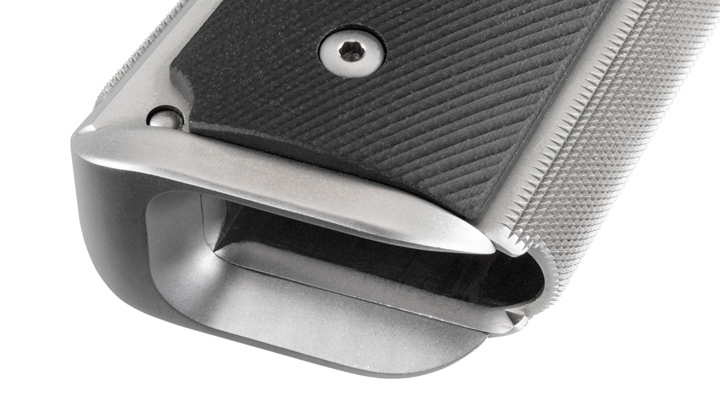
Finally, beginning at 50 seconds both pistols are shot simultaneously, with one ghosted over the other, and at 54 seconds you can clearly see the Combat Special is still in full recoil when the Fire Hawk has already recoiled and already back on target. The same thing can be seen at 59 seconds. Similarly, the video does a great job showing the Fire Hawk had a much more shallow recoil arc compared to the Combat Special.
In the accuracy department, the Fire Hawk delivered quite well across a wide range of bullet weights. All three loads tested performed more than adequate for self-defense purposes, the best of which was a minuscule 1.29 inch achieved with Colt NM Doubletap 124-grain FMJ at 15 yards. Equally surprising was that the porting had little effect on velocity. (Chronograph readings only varied 20 to 60 fps respectively, compared to the published data printed on the ammo boxes) a negligible difference that also had little to no affect on the pistol’s overall accuracy.
Night Hawk Custom’s Fire Hawk blends modern-day craftsmanship with time-proven recoil compensation features that effectively tames America’s war horse.
Shooting Results
Velocity measured in fps 10 feet from the muzzle for 10 consecutive shots with an Oehler Model 36 chronograph. Temperature: 78 degrees Fahrenheit. Accuracy measured in inches for five consecutive, five-shot groups slow fired from an offhand position at 15 yards.

Specifications
- Manufacturer: Nighthawk Custom; (877) 268-4867, nighthawkcustom.com
- Action Type: Recoil-operated, semi-automatic
- Caliber: 9 mm (tested), .45 ACP
- Capacity: 8+1 rounds
- Frame: Steel
- Slide: Stainless steel
- Barrel Length: 5 inches
- Sights: Heinie Slant Pro rear; 14-Karat-gold bead front
- Trigger Pull Weight: 4 pounds, 2 ounces
- Length: 8.47 inches
- Width: 1.30 inches
- Height: 5.6 inches
- Weight: 43.8 ounces
- Accessories: Carry bag, two 8-round magazines, fired brass case, takedown tool, test target, Allen wrench, manual
- MSRP: $4,199












